The beginnings of the Jávea Yacht Club The space in which the Jávea Nautical Club is located is intimately linked to the works of the Levante Pier. The major engineering work of the time dates back to 1949, when the design of the new seawall and contradiction was created, which would replace the scarce rocks with solid concrete blocks. The project was written by engineer Vicente Vicioso Vidal, of the Ports Group of Alicante-Valencia, and was awarded to contractor Bernal Pareja S.A. on January 28, 1952 for 18,520,265 pesetas. Work began in 1952, the first phase of the mega-project, but not until 1973, when finally cleared recent work, which would leave East and West sports, as we know them today.
In 1956, a second restructuring would include larger basins connected to the contradiction (Poniente breakwater) as a result of fisheries renewal. All the breakwater reforms would be done from the beginning to benefit the local fishing industry, a strong pillar at that time for the livelihood of the fishing district of Aduanas de la Mar. The dams were the biggest local attraction at the time for five years. People referred to the Levante Dam as a “dam” and according to the testimonies of old fishermen, then the townspeople and surrounding approached the customs to see the progression of the work, something unheard of at the time.
Beginning in 1957, when it began to see the end of riparian work, construction began on docks for small boats and between them a service road for machinery passage (now road access to the Club and parking lot).
Behind the current Club parking lot, across from the old infirmary, one can still see, in relatively good condition and half hidden among the trees, the building in which the stone used to build the Levant Dam and rails milled with which the wagons evacuated excess rock from the mountain excavation. The only existing buildings in the area in the 1950s belonged to the Shipwreck Rescue Society. A tangone or Tangó LIFEBOAT, located on a promontory in the bay of the same name, which served as a shelter fishermen could not approach the coast in case of rough seas, in the absence of a sheltered ports.
There was another building in the ports, which would be known years later as “Casa del Contramaestre.” The first headquarters of the Jávea Yacht Club was formed by an agreement between the Shipwreck Rescue Society and, on behalf of the Club, the then president, Jaime Cruañes Cholbi, and secretary Juan Crespo Ruaño. As stated in the 1958 constitution, “the occupancy of the building and other equipment they own at this local station is established, so that until the final site is resolved, it is considered a social building.”
The old building was renovated and qualified as headquarters. Later it would be the home of the boatswain’s mate and machine shop. That was the first headquarters of the Jávea Nautical Club, a dilapidated building used in 1955 as a nautical store where peons and dam workers were sheltered from the cold. The building would later host the meetings of the first board of directors of Jaime Cruañes and the few members who owned a club still in diapers.
Much has changed since then, though perhaps only on the outside, because the entrepreneurial spirit of the early partners is still alive in 2008, 50 years later. Introduced in 1964, the Yacht Club had already obtained the necessary administrative concession to develop its nautical activities. Jaime Cruañes left office with duties performed and a new president took over. D. Federico Noreña Echeverría grabbed from the reins a Club that had already begun to grow dramatically. He was inaugurating the presidency with a new headquarters and a very modest dock, right in front of the Club’s old entrance.
The neat “six hundred” in the parking lot contrasted with the messy little boats in the two small dry docks that could not cope with so many nut shells. The social building dates back to 1964. A few years later it would be expanded with the pool and concierge buildings, located next to the old dance floor, where so many parties were held during the years when we saw everything in black and white with rhythmic beats and the sound of Pekenikes The Nautical Club continued to grow rapidly and by the 1970s its membership numbered in the hundreds. In those years, the building where the Sailing School is today is created, the main entrance to the Club is moved to where it is today, the infirmary is created and next to it, the new secretariat.
At the local level, the final design of the port’s fish market began in 1977 and was rebuilt in 1995. It was also at that time that we received an illustrious visit, such as that of D. Juan de Borbón, who was seen more than once crossing the Bay of Javea.









